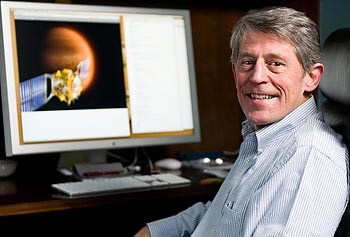Data Will Help Scientists Decipher Satellite Measurements

01/17/2013
By Edwin L. Aguirre
Prof. Robert Gamache of the Environmental, Earth and Atmospheric Sciences (EEAS) Department loves to study the atmospheres of planets. He has devoted his professional career analyzing the atmospheric spectral lines of Earth, Venus and Mars, as measured by orbiting satellites.
Recently, the National Science Foundation (NSF) has awarded Gamache a three-year grant worth more than $434,000 to establish the spectral “line shape” parameters for important gas molecules found in the planets’ atmospheres. Spectral line shapes can tell us a lot about the physical conditions in the atmosphere, including the pressure, temperature and concentration profiles of the gases.
“We have to improve the databases for these parameters all the time since our space-based instruments are getting better and better,” says Gamache, who currently serves as UMass associate vice president for academic affairs, student affairs and international relations.
“Line shapes are the weakest link in interpreting data right now, as they had been for a long time,” he says. “There are hundreds of thousands of lines for every molecule we’re interested in, but we can’t measure them all. So what we’ve been trying to do is to calculate these lines theoretically.”
Like the Rosetta Stone
Gamache and his team of EEAS undergraduate students and postdoctoral researcher first calculate the molecule’s fundamental physical parameters. They then either create databases or contribute their data to existing databases for Earth, Venus and Mars.
“Our lab is considered to be the best in the world for these kinds of cutting-edge calculations,” notes Gamache.
He says based on the information they provide, scientists can obtain a complete picture of the chemistry of an atmosphere as a function of altitude.
“When you study it over time, it gives you a sense of the dynamics of the atmosphere, such as its wind vectors,” he explains. “So you can study the chemistry, dynamics and evolution of the planet’s atmosphere.”
He says without the numbers, scientists will not be able to unravel the data they have collected.
“They need the spectral parameters,” notes Gamache. “Like the Rosetta Stone, the parameters allow them to unlock and decipher their data.”
Research on Climate Change
“My work is also directly related to Earth’s changing climate since the measurements we make on Mars and Venus are really not different from those we make here, other than in what we call ‘broadening’ gases, which are gases that are colliding with the molecules of interest,” explains Gamache. “Here on Earth, the gases are mostly nitrogen and oxygen; on Venus and Mars, it’s predominantly carbon dioxide.”
Gamache was involved in the early '80s in the study of ozone depletion over Antarctica, and is now conducting a lot of work with the European Space Agency (ESA). He has also studied carbon dioxide and methane as greenhouse gases. He says many people don’t realize it, but water vapor is still Earth’s biggest greenhouse gas.
"It’s a very difficult molecule to study because the dynamical range of its parameters is so large,” he says.
Gamache’s work has supported many space missions, including the Aqua and Aura satellite programs of NASA’s Earth Observing System, the Orbiting Carbon Observatory, Venus Express, the Mars Reconnaissance Orbiter and several ESA satellite programs of EUMETSAT and the National Centre for Space Studies (CNES).
For more information, go to Gamache’s website.
